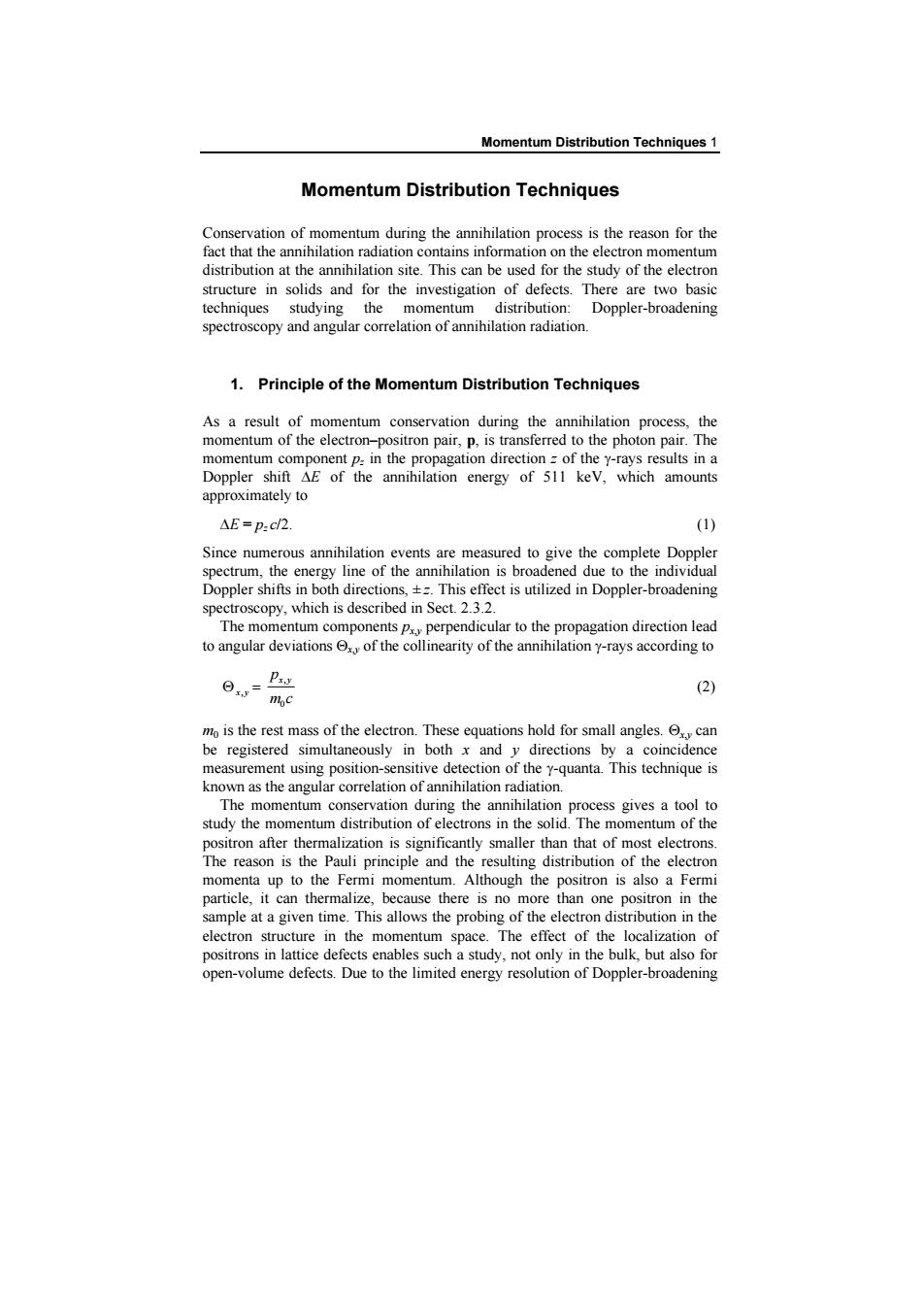正在加载图片...

Momentum Distribution Techniques 1 Momentum Distribution Techniques Conservation of momentum during the annihilation process is the reason for the fact that the annihilation radiation contains information on the electron momentum distribution at the annihilation site.This can be used for the study of the electron structure in solids and for the investigation of defects.There are two basic techniques studying the momentum distribution:Doppler-broadening spectroscopy and angular correlation of annihilation radiation. 1.Principle of the Momentum Distribution Techniques As a result of momentum conservation during the annihilation process,the momentum of the electron-positron pair,p,is transferred to the photon pair.The momentum component p:in the propagation direction of the y-rays results in a Doppler shift AE of the annihilation energy of 511 keV,which amounts approximately to △E=p-c/2 (1) Since numerous annihilation events are measured to give the complete Doppler spectrum,the energy line of the annihilation is broadened due to the individual Doppler shifts in both directions,+=.This effect is utilized in Doppler-broadening spectroscopy,which is described in Sect.2.3.2. The momentum components p perpendicular to the propagation direction lead to angular deviations x of the collinearity of the annihilation y-rays according to Θw= (2) mc mo is the rest mass of the electron.These equations hold for small angles.can be registered simultaneously in both x and y directions by a coincidence measurement using position-sensitive detection of the y-quanta.This technique is known as the angular correlation of annihilation radiation. The momentum conservation during the annihilation process gives a tool to study the momentum distribution of electrons in the solid.The momentum of the positron after thermalization is significantly smaller than that of most electrons. The reason is the Pauli principle and the resulting distribution of the electron momenta up to the Fermi momentum.Although the positron is also a Fermi particle,it can thermalize,because there is no more than one positron in the sample at a given time.This allows the probing of the electron distribution in the electron structure in the momentum space.The effect of the localization of positrons in lattice defects enables such a study,not only in the bulk,but also for open-volume defects.Due to the limited energy resolution of Doppler-broadeningMomentum Distribution Techniques 1 Momentum Distribution Techniques Conservation of momentum during the annihilation process is the reason for the fact that the annihilation radiation contains information on the electron momentum distribution at the annihilation site. This can be used for the study of the electron structure in solids and for the investigation of defects. There are two basic techniques studying the momentum distribution: Doppler-broadening spectroscopy and angular correlation of annihilation radiation. 1. Principle of the Momentum Distribution Techniques As a result of momentum conservation during the annihilation process, the momentum of the electron–positron pair, p, is transferred to the photon pair. The momentum component pz in the propagation direction z of the g-rays results in a Doppler shift DE of the annihilation energy of 511 keV, which amounts approximately to DE = pz c/2. (1) Since numerous annihilation events are measured to give the complete Doppler spectrum, the energy line of the annihilation is broadened due to the individual Doppler shifts in both directions, ± z. This effect is utilized in Doppler-broadening spectroscopy, which is described in Sect. 2.3.2. The momentum components px,y perpendicular to the propagation direction lead to angular deviations Qx,y of the collinearity of the annihilation g-rays according to Qx y x y p m c , , = 0 (2) m0 is the rest mass of the electron. These equations hold for small angles. Qx,y can be registered simultaneously in both x and y directions by a coincidence measurement using position-sensitive detection of the g-quanta. This technique is known as the angular correlation of annihilation radiation. The momentum conservation during the annihilation process gives a tool to study the momentum distribution of electrons in the solid. The momentum of the positron after thermalization is significantly smaller than that of most electrons. The reason is the Pauli principle and the resulting distribution of the electron momenta up to the Fermi momentum. Although the positron is also a Fermi particle, it can thermalize, because there is no more than one positron in the sample at a given time. This allows the probing of the electron distribution in the electron structure in the momentum space. The effect of the localization of positrons in lattice defects enables such a study, not only in the bulk, but also for open-volume defects. Due to the limited energy resolution of Doppler-broadening